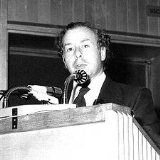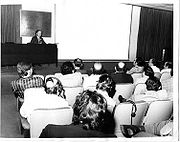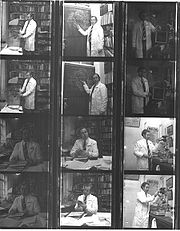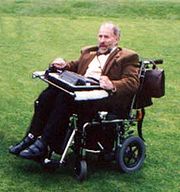
Sydney Selwyn
Encyclopedia

He was a medical microbiologist
Microbiologist
A microbiologist is a scientist who works in the field of microbiology. Microbiologists study organisms called microbes. Microbes can take the form of bacteria, viruses, fungi, and protists...
with an interest in bacteriology
Bacteriology
Bacteriology is the study of bacteria. This subdivision of microbiology involves the identification, classification, and characterization of bacterial species...
, authority on the history of medicine, avid collector, writer, lecturer, world traveller, and occasional radio and TV broadcaster.
Life
Sydney Selwyn was born in Leeds, UK, 7 November 1934 and died in London, UK, 8 November 1996.Selwyn's parents owned and ran a butcher shop in Leeds and originally expected him to follow them in their trade or at least something similar. He chose instead to devote his life to science and academia. As a working class boy growing up in England in the 1930s, and during World War II
World War II
World War II, or the Second World War , was a global conflict lasting from 1939 to 1945, involving most of the world's nations—including all of the great powers—eventually forming two opposing military alliances: the Allies and the Axis...
, it was a great achievement for him to win a scholarship to be educated at the prestigious and ancient Leeds Grammar School
Leeds Grammar School
Leeds Grammar School was an independent school in Leeds established in 1552. In August 2005 it merged with Leeds Girls' High School to form The Grammar School at Leeds. The two schools physically united in September 2008....
. He then went on to study at the University of Edinburgh
University of Edinburgh
The University of Edinburgh, founded in 1583, is a public research university located in Edinburgh, the capital of Scotland, and a UNESCO World Heritage Site. The university is deeply embedded in the fabric of the city, with many of the buildings in the historic Old Town belonging to the university...
from which he graduated with a BSc, MB ChB, and MD.
He worked briefly (from 1959–1960) as a house physician in Edinburgh City Hospital before becoming a lecturer in bacteriology at University of Edinburgh Medical School
University of Edinburgh Medical School
The University of Edinburgh Medical School is part of the College of Medicine and Veterinary Medicine of the University of Edinburgh. Established nearly 283 years ago, Edinburgh Medical School is one of the oldest medical schools in Scotland and the UK...
(1961–1966). In 1967 he became one of the youngest-ever visiting professors for the World Health Organization
World Health Organization
The World Health Organization is a specialized agency of the United Nations that acts as a coordinating authority on international public health. Established on 7 April 1948, with headquarters in Geneva, Switzerland, the agency inherited the mandate and resources of its predecessor, the Health...
(WHO) at Baroda University
Maharaja Sayajirao University of Baroda
The Maharaja Sayajirao University of Baroda, commonly referred as M. S. University , is a university in the city of Vadodara, in Gujarat state, India...
in India, as well as a WHO SE Asia medical consultant. He toured India extensively, visiting not only towns and cities but also many remote rural areas as part of his WHO project to greatly improve the standards of health and hygiene at various hospitals. He returned from India to become first Reader, then Consultant and finally Professor of Medical Microbiology
Medical microbiology
Medical microbiology is both a branch of medicine and microbiology which deals with the study of microorganisms including bacteria, viruses, fungi and parasites which are of medical importance and are capable of causing infectious diseases in human beings...
at Westminster Medical School
Westminster Hospital Medical School
The Westminster Hospital Medical School was formally founded in 1834 by George Guthrie, an ex-military surgeon - although students had been taken on at Westminster Hospital almost from the hospital's foundation in 1719 .The hospital and medical school moved to larger buildings several times in the...
, University of London
University of London
-20th century:Shortly after 6 Burlington Gardens was vacated, the University went through a period of rapid expansion. Bedford College, Royal Holloway and the London School of Economics all joined in 1900, Regent's Park College, which had affiliated in 1841 became an official divinity school of the...
.
Whilst continuing as Professor at Westminster Medical School he also simultaneously became Professor of Medical Microbiology at Charing Cross Hospital Medical School
Charing Cross Hospital Medical School
Charing Cross Hospital Medical School is the oldest of the constituent medical schools of Imperial College School of Medicine.-History:...
, thus running two separate departments (each with its own research and teaching teams) in two different teaching hospitals.

Bone marrow transplant
Hematopoietic stem cell transplantation is the transplantation of multipotent hematopoietic stem cell or blood, usually derived from bone marrow, peripheral blood stem cells, or umbilical cord blood...
ation. In particular he was closely involved with the treatment of two ground-breaking cases; those of Simon Bostic and Anthony Nolan. Anthony Nolan's mother went on to found the charitable Anthony Nolan Trust.
Research in the fields of bacteriology and medical microbiology were not his only professional interests. Despite his demanding research activities he also developed world-class expertise in the history and development of medicine, from the dawn of civilization to the then present day, and also became a distinguished and popular lecturer in that subject.
He was honorary archivist of the Royal College of Pathology
Royal College of Pathologists
The Royal College of Pathologists, founded in 1962, was established to co-ordinate this development and maintain the internationally renowned standards and reputation of British pathology. Today the College advises on a vast range of issues relating to pathology...
of which he was also a Fellow (FRCPath), President of the Faculty of History and Philosophy of Medicine and Pharmacy, President of the Medical Sciences Historical Society and a Liveryman of the Worshipful Society of Apothecaries where he was also Director of the DHMSA (the Diploma of the History of Medicine at the Society of Apothecaries), an important and popular course and diploma, to which some students even flew in from across Europe (and one from Canada) each week to attend! He led this course to new heights of popularity over the seventeen years of his tenure, until ill health forced his retirement in 1990.
He was an active member of many prestigious research and educationally based clubs and organisations, for example being President of the Osler Club of London and President of the Harveian Society of London (1991–92).
Writer
He wrote, as well as co-authored, a number of books and a great number of scientific papers. One of his most accessible and delightful publications (in collaboration with his predecessor Professor R W Lacey and research assistant and colleague Mohammed Bakhtiar) was "The beta-lactam antibiotics: penicillins and cephalosporins in perspective."Design for a banknote
His diverse interests in many fields often led to involvement in unusual projects both large and small. For example as an authority on the history of medicine he was approached by the Bank of EnglandBank of England
The Bank of England is the central bank of the United Kingdom and the model on which most modern central banks have been based. Established in 1694, it is the second oldest central bank in the world...
to suggest a medical theme for the £10 note. He not only suggested Florence Nightingale
Florence Nightingale
Florence Nightingale OM, RRC was a celebrated English nurse, writer and statistician. She came to prominence for her pioneering work in nursing during the Crimean War, where she tended to wounded soldiers. She was dubbed "The Lady with the Lamp" after her habit of making rounds at night...
as a subject but went on to recommend they base their design on a "classic" scene of her carrying her famous lamp, which had earned her the nickname "The Lady With The Lamp," around a ward of the Military Hospital at Scutari during the Crimean War
Crimean War
The Crimean War was a conflict fought between the Russian Empire and an alliance of the French Empire, the British Empire, the Ottoman Empire, and the Kingdom of Sardinia. The war was part of a long-running contest between the major European powers for influence over territories of the declining...
. When the Bank of England was unable to track down the particular steel engraving he had recommended he lent them a copy of the rare print from his collection.
The Florence Nightingale £10 banknote was first issued in February 1975 and proved extremely popular (leading for a while to the £10 note being nicknamed "a Flo" by some, as in "excuse me - have you got change for a Flo"). It was not withdrawn until May 1994.
Broadcasts
Following several brief but popular broadcasts he gave on the dangers of licking postage stamps (particularly in countries that used crude forms of "cow gum" made from bones that could contain a worrying variety of still active diseases) he was consulted by De La Rue and the Walsall Security Printing companies who were early pioneers of self adhesive stamps. One of the resulting projects he became involved with was the development of a set of self adhesive stamps featuring historic post boxes for GibraltarGibraltar
Gibraltar is a British overseas territory located on the southern end of the Iberian Peninsula at the entrance of the Mediterranean. A peninsula with an area of , it has a northern border with Andalusia, Spain. The Rock of Gibraltar is the major landmark of the region...
.
He appeared a number of times as "a medical expert" on television. For example in the 1970s he was interviewed by Frank Bough
Frank Bough
Frank Bough is a retired British television presenter who is best known as the former host of BBC sports and current affairs shows including Grandstand, Nationwide and Breakfast Time, which he fronted alongside Selina Scott.-Early life:...
on the BBC's then popular "Nationwide
Nationwide (TV series)
Nationwide was a BBC News and Current affairs television programme broadcast on BBC One each weekday following the early evening news. It followed a magazine format, combining political analysis and discussion with consumer affairs, light entertainment and sports reporting...
" programme shown on prime family-time TV. Selwyn introduced himself on the programme as a microbiologist and bacteriologist with an interest in dermatological matters such as the flora and fauna of our skin. He went on to explain that through his researches he had come to realise most of us were using far too many chemical-based cosmetics and, as a result, disrupting the ecology of our skin. This resulted, he said, in building-up a dependence on more of these otherwise unnecessary cosmetics. He suggested that clean water and small amounts of simple soap were ample and that most of the available cosmetics and personal hygiene products being advertised were not just unnecessary but also potentially harmful especially through habitual over use.
He worked with the BBC on a number of projects which included, for example, "Horizon" documentaries and "Microbes and Men" (1974).
Last years and final illness

Whilst barely in his 50s Professor Selwyn was diagnosed as suffering from "multiple system atrophy
Multiple system atrophy
Multiple system atrophy is a degenerative neurological disorder. MSA is associated with the degeneration of nerve cells in specific areas of the brain. This cell degeneration causes problems with movement, balance and other autonomic functions of the body such as bladder control or blood pressure...
" (MSA), and told he might have only around 5–9 years left to live. However, even after being forced to take early retirement several years later he continued to write and publish in addition to travelling.
Despite his physical decline during his last decade or so he managed to retain not only his dignity and sense of humour but his passion for life also. Refusing to lose his mobility or become passive he instead delighted in learning to drive a new electrically driven self-propelled wheelchair
Motorized wheelchair
A motorized wheelchair, powerchair, electric wheelchair or electric-powered wheelchair is a wheelchair that is propelled by means of an electric motor rather than manual power...
. Eventually, as his condition worsened he lost his ability to speak, but, again undaunted, he learned to communicate by typing a single letter at a time on his lightwriter
Lightwriter
Lightwriters are a type for Speech generating device.Lightwriter is the brand name of Toby Churchill Limited, a British company founded by Toby Churchill.-About Lightwriters:...
which had a built-in voice synthesiser.
He enjoyed a private family party in his honour for his 62nd birthday and was as full of enthusiasm and humour as ever (though of course had some difficulty in expressing it). He died peacefully at home later the following day.
Memorials
A room in the laboratory block of the Charing Cross HospitalCharing Cross Hospital
Charing Cross Hospital is a general, acute hospital located in London, United Kingdom and established in 1818. It is located several miles to the west of the city centre in the London Borough of Hammersmith and Fulham....
(now part of Imperial College) used for both meetings and teaching or training has been named "The Sydney Selwyn Room" in his memory. His photograph and a plaque summarising his contribution to the hospital is displayed on the wall.
Early each year "The Selwyn Prize" is awarded by The Faculty of History And Philosophy of Medicine and Pharmacy at the historic premises of the Worshipful Society of Apothecaries
Worshipful Society of Apothecaries
The Worshipful Society of Apothecaries of London is one of the Livery Companies of the City of London. Originally, apothecaries were members of the Grocers' Company and before this members of the Guild of Pepperers formed in London in 1180...
in London to the best candidate from the previous year in the examination for the Diploma in the Ethics and Philosophy of Healthcare (Philosophy of Medicine). Receiving this prize, which is usually presented at the John Locke Lecture, is an impressive achievement as the standard and quality of candidates entering the examination is generally very high.
This year's prize winner (2009, for the 2008 examination) is Christopher Mark Crawshaw. His major essay was entitled "The health of the people is the highest law: Political Philosophy and Healthcare in the 21st century."
Previous prize winners are:
- 2008 - Dr. Katherine Elen Catford
- 2007 - Michael Trent Herdman
- 2006 - Paul Bingham & Edith Rom
- 2005 - Caroline Bagley & Ben Whitelaw
- 2004 - Robert Ali
External links
- http://www.osler.org.uk/HTML/Preside.htm President of the Osler Club (1991–92)
- http://www.thackraymuseum.org/ http://www.thackraymuseum.org/library-and-resource-centre.html
- http://www.bartsandthelondon.nhs.uk/aboutus/museums_and_archives.asp Bartholomew's Hospital London
- http://www.apothecaries.org/index.php?page=30 The Selwyn prize is awarded to the best candidate in the examination for the Diploma in the Philosophy of Medicine and it is usually presented at the John Locke Lecture.
- http://www.veryreasonable.com/sydney/Sydney-Selwyn--medhist00027-0108.pdf (Alternative copy of obituary by Robin Price)
- http://scholar.google.com/scholar?q=%22sydney+selwyn%22&hl=en&lr=&start=0&sa=N Google Scholar - links to some publications by the late Prof S Selwyn
- http://www.worldcat.org/isbn/0340225238 The beta-lactam antibiotics: penicillins and cephalosporins in perspective by Sydney Selwyn; R W Lacey; Mohammed Bakhtiar / London : Hodder and Stoughton, 1980 ISBN 0-340-22523-8 9780340225233
- http://www.cvphm.org/Stamps.html gibralta self adhesive stamps 1974
- http://www.cvphm.org/release/Gib%20book.jpg
- http://www.stampprinters.info/SPI_Walsall.htm Walsall Security Printers Limited (WSP)
- http://www.boonham.com/cv.htm A bust in bronze of Prof S Selwyn was produced in 1982 from live sittings by NIGEL BOONHAM (a well known British sculptor who has had many important commissions to sculpt many famous people including a bronze of Diana, Princess of Wales that was unveiled by the Princess herself at the National Hospital of Neurology)
- http://www.veryreasonable.com/sydney/ Further information including more external links
- http://www.bbc.co.uk/shropshire/features/2003/08/frank_bough.shtml Frank Bough former presenter for the BBC, including of "Nationwide"
- The Anthony Nolan Trust a charitable organisation devoted to supporting all those with immune system disorders.
- MSAMultiple system atrophyMultiple system atrophy is a degenerative neurological disorder. MSA is associated with the degeneration of nerve cells in specific areas of the brain. This cell degeneration causes problems with movement, balance and other autonomic functions of the body such as bladder control or blood pressure...
(Multiple system Atrophy)

